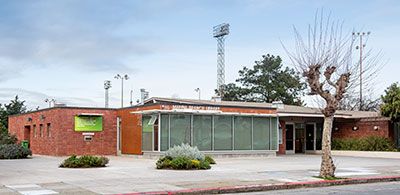San Francisco Landmarks
Marina Branch Library
1890 Chestnut Street
Built 1953
Between 1951 and 1966, the architectural firm of Appleton & Wolfard designed eight branch libraries in San Francisco, more than any other firm in the city's history. This was a period of unprecedented commitment at the local, state and national levels to develop and modernize public libraries.
Appleton & Wolfard were influenced by contemporary Scandinavian architecture, notably Finnish architect Alvar Aalto.
The Marina Branch was rehabilitated in 2007 and retains the majority of its character-defining features and possesses a high level of architectural integrity.
Source: Adapted from San Francisco Planning Department Case Number 2008.09681

The landmark designation document contains two quotes that exemplify the Utopian thinking common in the middle of the 20th century.
"The best of the new buildings show that a basic change in concept is taking place. The library is no longer a mere symbol of culture of a civic monument with pillars and impressive masses of steps: instead it is becoming a friendly place which reveals the resources within and invites one to share its hospitality. Simplicity of form, openness and a functional layout are its basic characteristics." (Librarians Charles M. Mohrhardt and Ralph A. Ulveling in a 1952 issue of Architectural Record)
"These days...a public library must merchandise its services in much the same way a successful bookshop sells its wares. It must entice people, both young and old, to want to use it. Unfortunately, most existing public libraries look like a Water Department pumping station. Smart entrepreneurs make their cocktail lounges so attractive that you can't help but stay on for another drink. Why not libraries?" (City Librarian Laurence J. Clarke, San Francisco Chronicle article in 1951)

Like all Utopian thinkers, these librarians seem to be as enthusiastic about destroying the past as they are about building the future.
